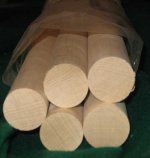I wasn't going to get involved in this conversation but since everyone has an opinion, I just thought I'd offer out a few thoughts. We handle more maple and that's what we're discussing here, in one year than all cue makers will handle in their lifetimes.
Maple from New York, Pennsylvania and Wisconsin is unacceptable, at least to us because it does not afford us the traits necessary to be a great hard rock maple shaft. You can get good maple for furniture and broom handles in those area but not the best maple for shafts.
Everyone will agree that the finest maple comes from the upper peninsula of Michigan, Canada and Maine; yes Maine! Why? Because these areas have long winters and short summers; essential for great maple. Tight grains are the direct results of short summer growing seasons and long winters. This is why you'll get your tightest growth ring concentration from these areas. Logically, you'll get tighter ring concentration in a shorter period than other areas. So, yes while there may be old growth trees in New York with looser ring growth, those trees are not growing in upper Michigan, Canada nor Maine. And as such your denser shaft wood will be produced from the shorter summers of upper Michigan, Canada and Maine. Old growth Maple from these areas is considered old growth anywhere from 100 to 150 years in the aforementioned areas.
Adequate moisture and a long growing season result in a wide ring. A drought year may result in a very narrow one.
A 6" tree can never be considered old growth nor would any responsible person cut a 6 inch diameter tree.
Let us show you this picture which shows a genuine slow old growth shaft as great definition and a standard to which all tight grained shafts should be judged for a tight grained shaft. There are probably 35 rings to the inch. We have them at 40 rings too.
http://ep.yimg.com/ca/I/cuecomponents_2229_80673844
Logically speaking this could never occur in a 1" diameter tree or a 6" diameter tree unless it was subjected to long winters and short summers. The particular tree that this shaft came from was well over 100 years old as the logger was so proud to show us the tree and then it's cross sections. It was a beauty and proof that old growth and tight ring count can exist together. It's all about the growing season - short summers and long winters.
Now you may look to these photos for other examples of tight grained shafts:
http://ep.yimg.com/ca/I/cuecomponents_2227_5997828
Anything less than these are considered average or usual shafts for the species denoting tight grain. Some makers don't have access to this grade and quality so they accept lesser growth rings as being tight grained. Unless you have this comparison, you can become bulldozed into exactly what is a tight grained shaft. Now you have a comparison. Tight grained wood such as this almost always emanates for upper Michigan, Canada and Maine.
If you notice, these shaft are fairly white which is the result of the process of drying the wood. We had a choice of our supplier using a conventional kiln which would have produced darker wood or we could choose, as we did, a vacuum kiln which will produce whiter wood. Because our shafts come from Michigan, they are tight and dense as opposed to other areas.
Once again, slow growing old growth maple grows in the short summers and long winters of upper Michigan, Canada and Maine where the finest maple comes from.


